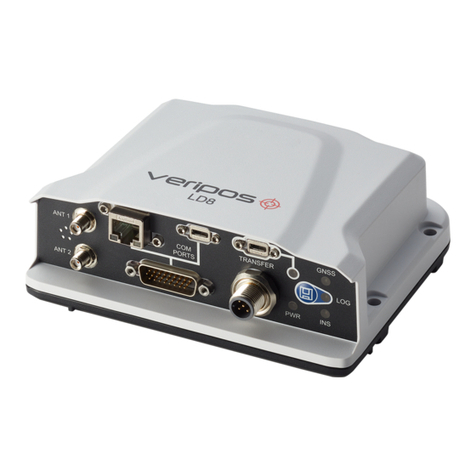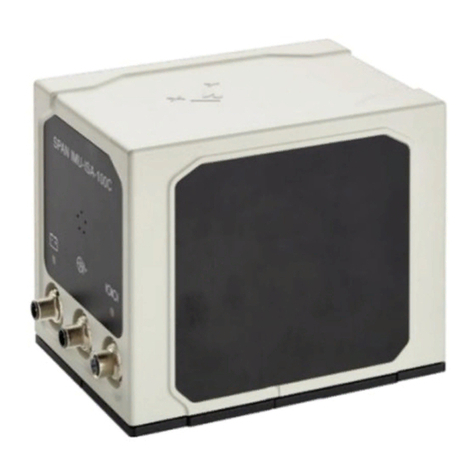Hexagon VERIPOS LD900 User manual

LD900
Installation and Operations Manual
AB-V-MA-00643_RevA3
26 February 2021

Contents
LD900 Installation and Operations Manual 2
Contents
Contents......................................................................................................................................... 2
1Introduction............................................................................................................................. 4
1.1 General Information....................................................................................................................................................4
1.2 LD900 Receiver..........................................................................................................................................................4
1.3 VERIPOS Support......................................................................................................................................................5
1.4 Activating VERIPOS Correction Services...............................................................................................................5
1.5 Terms and Abbreviations...........................................................................................................................................6
1.6 Document Conventions..............................................................................................................................................8
1.7 LD900 Notices.............................................................................................................................................................9
1.8 Disclaimer..................................................................................................................................................................12
1.9 Equipment Care........................................................................................................................................................13
2Hardware Overview.................................................................................................................14
2.1 System Overview......................................................................................................................................................14
2.2 Hardware Models......................................................................................................................................................14
2.3 Interface and Connectors........................................................................................................................................15
3LD900 Installation....................................................................................................................18
3.1 Schematic Examples................................................................................................................................................18
3.2 Rack Mount Formats................................................................................................................................................21
3.3 LD900 Location Guidelines.....................................................................................................................................24
3.4 LD900 Mounting........................................................................................................................................................24
3.5 Ventilation Requirements........................................................................................................................................25
3.6 Antenna Installation..................................................................................................................................................25
3.7 Cable Installation......................................................................................................................................................28
4Configuration and Operations..................................................................................................30
4.1 Start-Up......................................................................................................................................................................30
4.2 Front Panel Interface................................................................................................................................................30
4.3 Menu & Navigation Basics......................................................................................................................................30
4.4 Status (LD900L Model)............................................................................................................................................31
4.5 Status (LD900 & LD900M Models)........................................................................................................................31
4.6 Configuration.............................................................................................................................................................36
4.7 Receiver.....................................................................................................................................................................52
4.8 Help & Support..........................................................................................................................................................56
5Troubleshooting......................................................................................................................57
5.1 Hardware Issues.......................................................................................................................................................57
5.2 Power Issues.............................................................................................................................................................57
5.3 Activation Issues.......................................................................................................................................................57

Contents
LD900 Installation and Operations Manual 3
5.4 L-band Signal Issues................................................................................................................................................58
5.5 GNSS Signal Issues.................................................................................................................................................58
5.6 Corrections Issues....................................................................................................................................................59
5.7 GNSS Heading Issues.............................................................................................................................................59
5.8 INS Issues..................................................................................................................................................................60
6Reference Information.............................................................................................................61
6.1 Technical Specifications..........................................................................................................................................61
6.2 Cabling and Connectors..........................................................................................................................................63
6.3 Veripos H70 PC Specifications...............................................................................................................................65
6.4 LD900 Output Sentences........................................................................................................................................66
7Contact Information.................................................................................................................80
7.1 VERIPOS HelpdeskDetails....................................................................................................................................80
8Appendix................................................................................................................................81
8.1 Summary Specification of Antennas......................................................................................................................81
8.2 Summary Specification of Cabling.........................................................................................................................83
8.3 Default System Settings..........................................................................................................................................85
8.4 L-band Coverage Map.............................................................................................................................................86

Introduction
LD900 Installation and Operations Manual 4
1 Introduction
1.1 General Information
This documentprovides the information required to install and operate the VERIPOS LD900 receiver.
To assist with the installation and operation it will help to have the following items available when consulting this
document:
•VERIPOS LD900 and associated equipmentshipped to site.
•The Delivery note provided within the shipment.
•VERIPOS document Antenna and CoaxialCable Installation
•LD900 FAQs and QuickGuides, available from https://help.veripos.com.
1.2 LD900Receiver
The LD900 is a scalable integrated positioning sensor, operable as a basic L-band demodulator, or configurable
to meet demanding offshore positioning requirements as a fully integrated mobilepositioning unitwith multi-
frequencyGNSS receiver.Keysystemfeatures:
•Supports decimetre level multi-constellation positioning with VERIPOSApex and Ultra PPP solution
services
•Compatible with VERIPOS Quantum software
•EN60945 Marine Certified
•555 channels, multi-constellation, multi-frequency tracking
•Simultaneously track up to three L-band correction service satellites
•Features advanced signal filtering to mitigate the effects of interference
•Supports RTK operations
•Multiple communication interfacesfor easy installation
•Optional ALIGN® GNSS heading solution
•Optional SPAN® INS solution
•Optional MSKBeacon receive corrections from IALAmarine radio beacon network
•Optional UHF receiver for reception of corrections
•Optional 7 Portexpansion unit
•19 Inch Rack Mount options(for single ordual LD900 systems)
1.2.1 Preamble
The purpose of thismanualis to provide the information necessaryto install and operatethe VERIPOSLD900.
Read this manual in conjunction with the Deliverynote provided for yourinstallation.
This manual is split into the following sections:
1. Introduction - Details the purpose of the manual, conventionsand abbreviations.
2. Hardware Overview - Describesthe LD900interface panel andprovidestechnical data.
3. LD900 Installation - Covers the installation of the LD900 and providesantenna & cabling guidelines.
4. Configuration and Operations - Details system configuration and operationsvia the MMI.
5. Troubleshooting - Provides steps on howto rectify systemissues which a usermay encounter.
6. Reference Information -Providesdetailed technicalspecifications.
7. Contact Information - Containscontactinformation for the VERIPOSHelpdeskand VERIPOSoffices.
8. Appendix -Providesadditional supplementarymaterial.

Introduction
LD900 Installation and Operations Manual 5
1.3 VERIPOS Support
Throughout this manual, referencesare made to the VERIPOS Helpdesk.The Helpdeskis a service provided
as the first pointof contact forall VERIPOStechnical support and faultreports.It is manned24hoursa day,365
days per year. Full contact details are listed in the ContactInformation section.
Contact information for the VERIPOSHelpdesk can also be found onthe LD900 product label located on the
top of the unit or from the MMI Help &Support page.
For support cases, initialcontact should be made via support@veripos.com, or by raising a ticket
(https://help.veripos.com). With either method, the Helpdesk will be immediately notified and can begin
providing support.
The Helpdesk will provide initialsupport; however, tickets maybe escalated to regionalon-call engineersto
provide more in-depth technicalsupport if required.
To aid support,upon firstcontactit would be helpful if the following could be provided:
•Details of the issue or question
•Vessel name
•Companyname
•Telephone number
•Unit UserCode
•VERIPOS hardware type
•VERIPOS software type
•Operating area
•Is this issue holding up operations?
•Any otherrelevantinformation
1.4 Activating VERIPOS Correction Services
Correction services for the LD900 are provided on a subscription basisby VERIPOS.
To activate VERIPOSservices the user must firstsend a service activation request (containing the unit user
code, vessel name, SALnumber and services required) to the VERIPOSHelpdesk. Once processed, the
activation will then be sent via L-band satellite to the unit. The unit will start using VERIPOSservices upon
activation.
When not required, some service agreements mayallow for service deactivation.
NOTE
To use VERIPOS services a contract between the users’ company and VERIPOS must be in place. VERIPOS
refers to thisasa Service Access License (SAL).
To avoid delays users should record and provide theSALnumber associated withthe VERIPOS
equipment.
The Helpdesk are unable to activate any equipment unlessan active SAL exists.
Other manuals for VERIPOS LD900
2
This manual suits for next models
2
Table of contents
Other Hexagon Receiver manuals
























